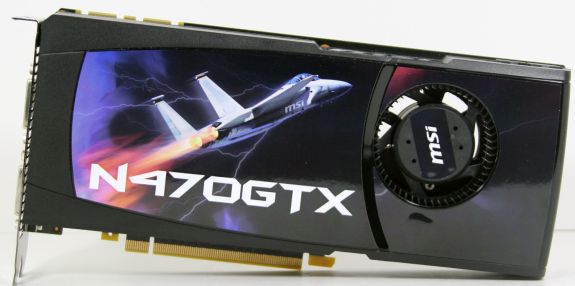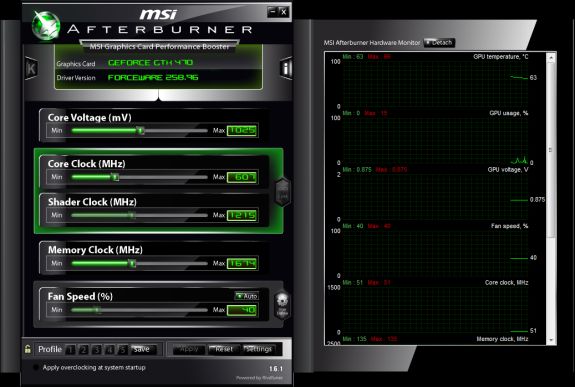MSI’s GeForce N470GTX & GTX 470 SLI
by Ryan Smith on July 30, 2010 1:28 PM ESTFor the launch of the first GF100-based video cards – the GTX 480 and GTX 470 – NVIDIA sent over a 3 card reviewer’s kit containing two GTX 480s and a single GTX 470. This allowed us to do SLI testing with the GTX 480 (a money-is-no-object setup) but not with NVIDIA’s significantly cheaper GTX 470. As part of a comprehensive SLI & CrossFire guide we’re working on for next month we needed a second GTX 470 for testing GTX 470 SLI operation, and MSI answered our call with their N470GTX.
Today we’ll be taking a look at MSI’s GTX 470. We’ll also be taking a sneak-peek of our forthcoming SLI/CF guide with a look at GTX 470 SLI performance.
| GTX 480 | GTX 470 | GTX 465 | GTX 460 1GB | GTX 285 | |
| Stream Processors | 480 | 448 | 352 | 336 | 240 |
| Texture Address / Filtering | 60/60 | 56/56 | 44/44 | 56/56 | 80 / 80 |
| ROPs | 48 | 40 | 32 | 32 | 32 |
| Core Clock | 700MHz | 607MHz | 607MHz | 675MHz | 648MHz |
| Shader Clock | 1401MHz | 1215MHz | 1215MHz | 1350MHz | 1476MHz |
| Memory Clock | 924MHz (3696MHz data rate) GDDR5 | 837MHz (3348MHz data rate) GDDR5 | 802MHz (3208MHz data rate) GDDR5 | 900MHz (3.6GHz data rate) GDDR5 | 1242MHz (2484MHz data rate) GDDR3 |
| Memory Bus Width | 384-bit | 320-bit | 256-bit | 256-bit | 512-bit |
| Frame Buffer | 1.5GB | 1.25GB | 1GB | 1GB | 1GB |
| FP64 | 1/8 FP32 | 1/8 FP32 | 1/8 FP32 | 1/12 FP32 | 1/12 FP32 |
| Transistor Count | 3B | 3B | 3B | 1.95B | 1.4B |
| Manufacturing Process | TSMC 40nm | TSMC 40nm | TSMC 40nm | TSMC 40nm | TSMC 55nm |
| Price Point | $499 | ~$300 | $249 | $229 | N/A |
MSI’s N470GTX is a reference-derived GeForce GTX 470 that’s largely – but not exactly – similar to the reference GTX 470. Clocked at the reference clocks of 607MHz core, 1215MHz shader, and 837MHz (3348MHz data rate) memory, the stock performance of the card is identical to the reference design. This also extends to cooling, where the card uses the reference GTX 470 cooler, and in terms of display capabilities with the card using the NVIDIA-standard 2xDVI + 1x HDMI configuration.
In terms of hardware, the biggest difference is the choice of component selection. MSI advertises this card of being part of their “Military Class” program, signifying that it uses solid state capacitors, chokes, and Hi-c (Tantalum) capacitors where appropriate. In practice the reference design already uses these types of components, however not in the number that MSI does. On our NVIDIA reference card there are a few locations for choke that were left open, whereas MSI has filled these locations with chokes.
With only minor differences for the hardware, the bigger differentiating feature for the N470GTX is the software. As is the case with the rest of their cards, MSI bundles the N470GTX with their dynamic duo of overclocking tools: Afterburner and Kombustor.
Afterburner is MSI’s Rivatuner-based overclocking and monitoring suite, and a wonderful tool altogether. Going beyond straightforward overclocking controls, graphing, and an OSD, the most unique feature in Afterburner is that it offers support for voltage control on most of MSI’s cards, allowing for greater overclocking potential than what can be achieved on stock voltage alone. In the case of the GTX 470, MSI even enables overvolting support on non-MSI cards by allowing overvolting to be used with any reference-alike cards using the same VRMs as the N470GTX. This is a particularly generous move on MSI’s behalf, as it would be trivial to limit this feature to just MSI cards.
Meanwhile Kombustor is MSI’s FurMark-based load testing utility. In practice it’s virtually identical to FurMark, replacing FurMark’s furry donut with a furry version of the MSI logo.
The other significant piece of software included in the package is a voucher from NVIDIA and Capcom for one of 3 Capcom games: Street Fighter IV, Resident Evil 5, or Dark Void. The voucher is in lieu of a specific pack-in title, which is an interesting take on the pack-in game concept. Pack-in games can be hit & miss depending on whether you like the game or not, so a voucher is a much more interesting way to go about things, as it lets the buyer pick from a variety of games. The downside of course is that you’ll need a broadband connection to download the game since it’s delivered purely as a downloadable title rather than having any kind of disc packed-in.

Rounding out the package is the usual collection: a driver/utility CD, a multilingual quick-start guide, 2 molex-to-6pin PCIe power adaptors, a DVI-to-VGA adaptor, and a DVI-to-HDMI adaptor. The warranty on the card is 3 years.
As of this writing, Newegg has the card listed at $299 with a $20 mail-in rebate from MSI. Depending on your feelings towards MIRs, this is either some $30 below the GTX 470 MSRP of $330 a few short weeks ago, or at $280 approaching the price of the cheapest Radeon HD 5850s. NVIDIA and MSI have done a great job of being price competitive here, and as a result the N470GTX is priced only a stone’s throw away from the 5850 while being appreciably faster and including a free game at a time when most 5850s do not.













41 Comments
View All Comments
erple2 - Saturday, July 31, 2010 - link
Normally I'd agree with you, but I think that Ryan hit the nail on the head. I can recall when NVidia and ATI were optimizing the specific internal compilers specifically for 3Dmark. Tuning for one specific engine (which is what they had to do) is very time consuming and difficult, and takes more time away from optimizing the drivers in general (or for a more "worthy" cause - another popular game).I seem to recall the optimizations were things like:
if product executable matches 3dmark.exe
then
do special tweaks that work only for the 3dmark app
else
do nothing
endif
I think that's the situation we're trying to avoid nowadays - optimizing specifically for a single executable (ultimately where you end up when you want your numbers to look "best"), hurts everything else but that one thing you're optimizing for.
There's a difference between optimizing for the API vs. the specific executable...
mapesdhs - Saturday, July 31, 2010 - link
I've spent some time trying to find out why my 8800GT SLI setup was the
same or faster than a friend's 4890 CF system. Using 3DMark06 did prove
very useful in working out the reason (shader performance). See:
http://www.sgidepot.co.uk/misc/pctests.html
http://www.sgidepot.co.uk/misc/stalkercopbench.txt
Thus, though I agree with Ryan about the dangers of GPU makers
optimising for these metrics, they can be revealing sometimes, in my
case coming to the conclusion that, if one is still playing older games,
then buying a newer card might not give that much of a speedup since
the newer design may focus on newer features.
What about including the Vantage results as a point of interest, kindof
a 'by the way' addition, but downplaying the importance of such data?
Focus on the game results, but include Vantage as an 'appendix' in
terms of presentation.
Ian.
Porksmuggler - Monday, August 2, 2010 - link
Wait, you're trying to find out why your 8800GT SLI is faster than 4890CF? You need to look elsewhere than the GPUs, 8800GT SLI is not even as fast as 4850 CF, I have both on otherwise identical setups. Your links show testing of just 3DMark06, and you tested with two entirely different systems?Ryan is spot on, don't use synthetic benchmarks to compare similar generation GPUs. They are primarily used for testing when the GPU is the constant.
It seems from the replies above there is confusion about how the coding/engine of a synthetic benchmark (so-called? really?) is very different from actual games. Reviewers do far better with a battery of games, as Anandtech uses for their articles.
imaheadcase - Saturday, July 31, 2010 - link
Thats listed in THE TEST, but its excluded from graphs.Would like to compare that to it, considering upgrading to this card from that.
anactoraaron - Saturday, July 31, 2010 - link
Yeah I noticed that also. More importantly I'd like to see 2 of those in SLI along with 2 5770s in CF. I think the 2 5770's in CF has been the best bang for your buck for awhile now, especially 2 can be had for $270AR. As I recall, the 5770 (single card setup) was ~5% less than what a 260 core 216 would get you but it was cheaper (about $30 less ATM at newegg). If you have the ability to do CF/SLI having 2 lower priced cards makes the 460/470 & 5850 decision easy IMO. However since SLI scales performance better it would be interesting to see if the added $60 for 2 260's is justified against 2 5770's.Maybe for the next article?
Kyanzes - Saturday, July 31, 2010 - link
MORE minimum frame rate measurements in the articles please!!! That's the whole essence of it! Ofc, for sheer comparison, max FPS could also be included for sure, but the MIN FPS is the real interesting part.Keep it up pls!!!!
One of the reasons I tend to check out HardOCP is that they include MIN FPS.
Please, please do it often. Do it every time.
Tunnah - Saturday, July 31, 2010 - link
awesome review as usual but how come the focus on the 470 ? i thought with the release of the 460 the 470 was kind of like..its the core i7 940 to the 920 - sure it's faster but the price difference doesn't warrant the minor speed bump, and it OC's like a dreamalso, from what i've read the 460 has amazing scaling with SLI..and the temperatures are better
but this is just what i've read in 1 review so waiting to read it here before i start to believe it :D
ggathagan - Saturday, July 31, 2010 - link
RTFA3rd sentence:
"As part of a comprehensive SLI & CrossFire guide we’re working on for next month we needed a second GTX 470 for testing GTX 470 SLI operation, and MSI answered our call with their N470GTX."
Tunnah - Saturday, July 31, 2010 - link
yeah i read it, was just saying it seemed a little redundant to do a full article on an overpriced card that was being overshadowed by a cheaper, newer revisionMatrices - Saturday, July 31, 2010 - link
The 460 numbers are still there, so what's to complain about?And the 470 can be had for $275 now rather than the $350 MSRP.
If you actually read the benchmarks, you'd see that it's hardly 'overshadowed' by the 460 on performance. It's noticeably faster in more demanding titles.